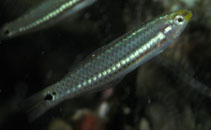| Family: |
Labridae (Wrasses), subfamily: Corinae |
| Max. size: |
4.7 cm SL (male/unsexed) |
| Environment: |
reef-associated; marine; depth range 0 - 7 m |
| Distribution: |
Western Central Atlantic: known only from Belize. Expected to be found elsewhere along the continental shores of the Caribbean Sea. |
| Diagnosis: |
Dorsal spines (total): 8-9; Dorsal soft rays (total): 11-12; Anal spines: 3-3; Anal soft rays: 11-12; Vertebrae: 25-25. Head and back gray-green with a narrow midlateral black-brown stripe from front of snout to caudal fin base, ending in a prominent black spot; second narrow brown stripe on lower side, the pale gray zone on the lower side between the two black-brown stripes bisected by a narrow white stripe; a narrow brown stripe on body at each side of base of dorsal fin, continuing middorsally on nape as a double stripe; occiput dark brown; the black caudal base spot rimmed with blue and white except posteriorly (Ref. 46844). |
| Biology: |
Inhabits shallow coral reefs over coral, sand, rubble or seagrass substrata (Ref. 46844). Forms tight coherent schools when chased (Ref. 80499). Feeds on zooplankton and forms evasive, compact schools when threatened (Ref. 46844). |
| IUCN Red List Status: |
Endangered (EN); Date assessed: 03 August 2015 (B1ab(i,ii,iii,v)+2ab(i,ii,iii,v)) Ref. (130435)
|
| Threat to humans: |
harmless |
Source and more info: www.fishbase.org. For personal, classroom, and other internal use only. Not for publication.

